In this series of three blog articles, adapted from the IoT M2M Times, we take a closer look at the energy consumption of NB-IoT and LTE-M. On their own, these physical layer standards do not deliver energy savings. The IoT developer has to choose the right AT commands and the right protocol with the right strategy for their chosen application. Sometimes as a result we have to do without NB-IoT and LTE-M and take a different path. We hope that you have fun reading and learning.
In this first article we compare NB-IoT/LTEM with GSM. In a nutshell, GSM was developed for voice communication and NB-IoT / LTEM was developed for data transmission, the different design objectives play out clearly in IoT applications to the advantage of one approach.
So, what can GSM do?
The original goal of GSM was a digital radio network for voice communication without the known problems of analogue radio networks. All carriers for transmitting data were added later.
In 1979, the 900 MHz frequency range was reserved for an unnamed mobile radio system for voice communication. This range was later extended to 1800 MHz in Europe and 850 MHz and 1900 MHz in the USA. In 1982, the CEPT (Conférence Européenne des Postes et Télécommunications) set up a working group called the “Groupe Spéciale Mobile”, or GSM for short. The goal was to develop a European mobile radio system. With the later worldwide spread of the technology, the meaning of GSM was changed to “Global System for Mobile Communications”. It was not until 1995 that fax, Circuit Switch Data (CSD), Short Message Service (SMS) and other functions were added in a second phase for data transmission. The packet-switched data service General Packet Radio Service (GPRS) was only added in 2000. GPRS enabled access to the Internet. After that came EGPRS.
Saving energy with GSM/GPRS
In order for a GSM/GPRS device to communicate it must be switched on. If an IoT device based on GPRS stays switched on in receive mode, it requires a constant current of 5 mA. With this current being continuously drawn, the battery is drained after only a few days. The only way to reduce energy consumption is to switch off the device. If the IoT device is switched off, an energy-hungry re-registration to the GSM/GPRS network is necessary when it is switched on again. An IoT device based on GPRS therefore can only operate in three modes: switched on to receive, switched on to transmit and switched off.
So what is NB-IoT?
NB-IoT is a radio network within a radio network. It is operated in the same frequency band as LTE. NB-IoT was specified from the start to operate on battery power and cannot transmit voice communication.
The history of NB-IoT from 2014
In 2014, Neul, a VC-based startup in Cambridge in the UK came up with the idea for a scalable, secure, robust and economical region-wide radio technology for network operators. For this purpose, the radio protocol for the licence-free band called Weightless was selected by the company. The existing protocol was adapted to use the licence-required bands of mobile radio. The goal was network services for small devices with low power consumption and connection to the cloud. Compared to GPRS, this new technology had a 20 dB higher link budget and thus better network coverage. The radio technology could operate in any frequency band below 1 GHz. Such a Neul-Weightless network required a frequency spectrum of only 180 kHz operating as a network within the network. This meant that a GSM subcarrier or 200 kHz from within the LTE spectrum was enough for it to operate. Neul offered small, powerful radio modules and the base station.
If you look closely, you can see the NB-IoT specification in the wording. NB-IoT uses only 180 kHz in a free spectrum within the LTE frequency band for 12 channels. The 20 dB greater link budget than GPRS is also found in NB-IoT. Huawei recognised the benefits of Weightless and bought Neul in September 2016 for £25 million. The world’s first NB-IoT chipset called Boudica 100 was launched by Huawei subsidiary Hisilicon in December 2016.
In 2022, we have already progressed to third generation NB-IoT chipset. In the paragraphs that follow we will explain how NB-IoT saves energy.
Power Save Mode PSM
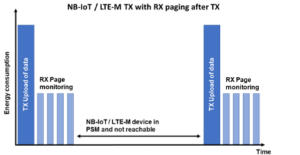
NBIoT_LTE-M Tx with RX paging after Tx
In PSM mode, the radio module is not completely shut down and the memory with the data for logging into the NB-IoT is not erased. With the memory active, the NB-IoT requires only 3 uA of continuous current. Completely shut down, it also requires approximately 3 uA, so there is little penalty to keeping the memory active.
The NB-IoT module informs the NB-IoT base station that it will shut down and stores the registration data. The NB-IoT base station acknowledges the request to shut down and also stores the registration data. The NB-IoT then enters PSM mode and is no longer accessible. The NB-IoT device can be woken up by the microcontroller at any time in the case of an event. In contrast to the first registration (attach), with the data preserved the new registration (called reattach) requires significantly less energy than the original attach.
Release Assistant Indication RAI
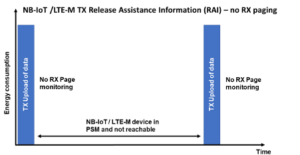
NB-IoT/LTE-M TX RAI energy consumption
With RAI, the NB-IoT network is informed that no receipt of data is expected after transmission. Water meters, bins for recyclables and many other IoT sensors do not require an acknowledgement after sending data. If the packet containing the status of the meter or the fill level is lost, it doesn’t matter because a new status is transmitted 12 or 24 hours later anyway. Shutting down the receive window saves up to 50 % of the energy of a data packet. If alarm messages with acknowledgements are required, RAI can be switched on and off dynamically. To use RAI, NB-IoT with UDP or CoAP/UDP must be used. TCP and MQTT based on TCP cannot work because the protocol requires acknowledgement. All protocols based on TCP are therefore not suitable for energy-saving with RAI.
Extended Discontinuous Reception eDRX
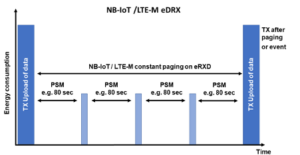
NB-IoT/LTE-M energy consumption with eDRX over time
The eDRX operating mode enables continuous receive operation. The approach is not new and has been used with pagers for decades. A Pocsag pager wakes up briefly every few seconds and checks whether a message is received. If it recognises from the group address that the message is not for it, it does not read in the complete address and immediately aborts the receive operation. With NB-IoT, there is also periodic continuous receiving (paging) with eDRX. In contrast to Pocsag, the reception window for paging is not statically set to seconds but can be dynamic from 20.48 to 10485.76 seconds (~175 minutes). The NB-IoT device informs the base station of the timer for the eDRX, receives an acknowledgement and is then periodically reachable.
NB-IoT energy saving summary
NB-IoT, like Bluetooth Low Energy, NeoMesh and Pocsag, requires little energy. The four wireless technologies save energy by switching off in intelligent ways. Switching off and not receiving saves the most energy. NB-IoT, Bluetooth Low Energy, NeoMesh and Pocsag pagers can receive continuously with little energy because receiving is synchronised via precise timers. This is called eDRX in NB-IoT. PSM is just a smart power down without really switching off. RAI is just a smart send without opening a receive window.
This flexibility means that the IoT developer must dynamically switch on or switch over the functions PSM, RAI and eDRX themself based on the requirements of their target application. Everyone must find the right strategy themselves. The same applies to searching for the radio network or switching from NB-IoT to LTEM and vice versa. LTEM modules offer the same timers. When to switch and how can be read in my guide to NB-IoT, LTEM and GSM which will help you find the best strategy for your IoT application. Enquiries about the guide can be sent to harald.naumann (at) lte-modem.comNBIoT in a matchbox
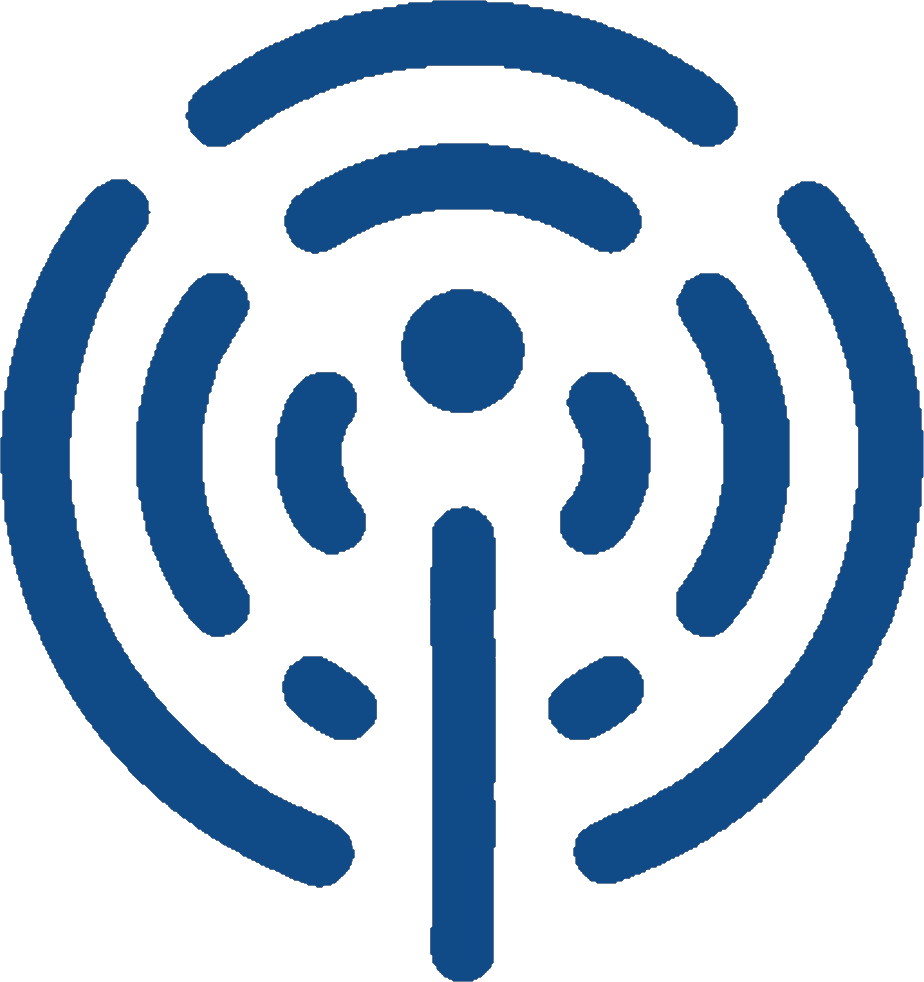

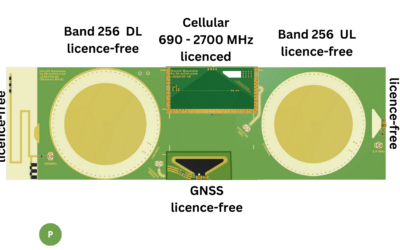
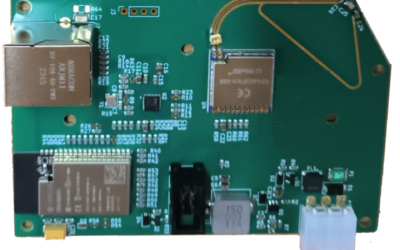
0 Comments